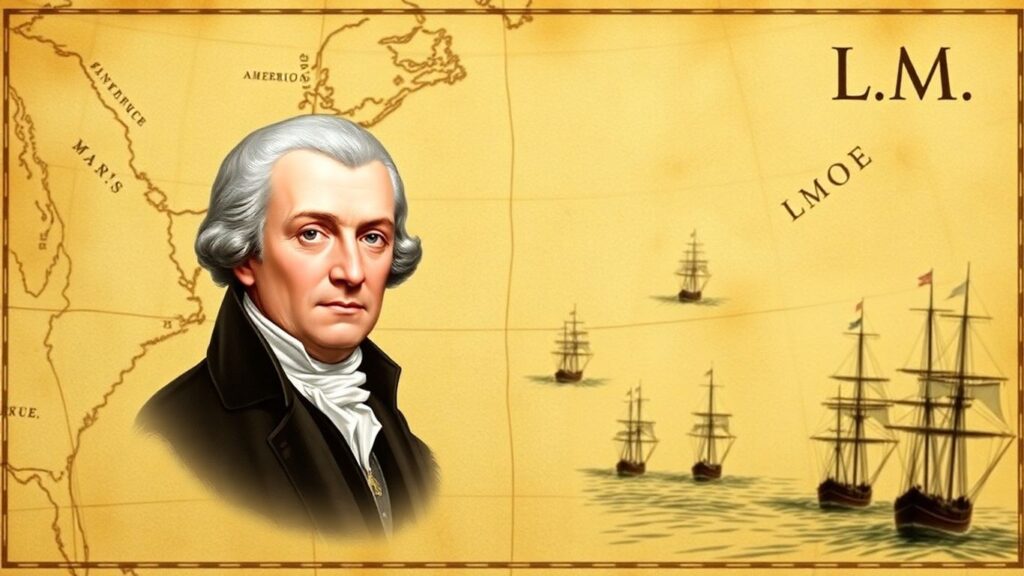Understanding the Monroe Doctrine: Its History and Lasting Impact

Hey everyone, let’s talk about something that’s been a big deal in American foreign policy for a long time: the Monroe Doctrine. It sounds pretty official, and it is. Basically, it’s a statement President James Monroe made way back in 1823. It was all about how the U.S. saw its place in the world, especially concerning Europe and the Americas. We’re going to break down what it actually meant, how it changed over the years, and why people still talk about it today. It’s a pretty interesting story with a lot of twists and turns.
Key Takeaways
- The Monroe Doctrine, first declared in 1823, aimed to prevent European powers from interfering in or colonizing the Americas.
- Initially, European nations largely ignored the Monroe Doctrine due to the U.S.’s limited power to enforce it.
- Over time, the doctrine evolved, notably with the Roosevelt Corollary, which expanded U.S. interventionist power in Latin America.
- The Monroe Doctrine has shaped U.S. foreign policy and inter-American relations for nearly two centuries, though its interpretation and application have been debated.
- While officially declared over by a Secretary of State in 2013, the legacy and impact of the Monroe Doctrine continue to be discussed in foreign policy circles.
The Genesis Of The Monroe Doctrine
A Declaration Of American Independence From European Affairs
Back in the early 1800s, the United States was still finding its footing on the world stage. Europe was a hotbed of old monarchies and ongoing conflicts, and America really wanted to steer clear of all that drama. President James Monroe, along with his Secretary of State John Quincy Adams, felt it was time to draw a line in the sand. They didn’t want European powers meddling in the affairs of the newly independent nations popping up in the Americas, nor did they want those same powers trying to set up new colonies. It was basically a way of saying, ‘This side of the Atlantic is our business, and you guys can keep your squabbles over there.’
Foundational Ideals And Diplomatic Precedents
This whole idea didn’t just come out of nowhere. It was built on earlier American thinking, like George Washington’s advice to avoid permanent alliances and James Madison’s stance on defending neutral rights during the War of 1812. The goal was to establish distinct zones: one for the old European powers and another for the Americas. It was a bold statement, especially considering the U.S. didn’t exactly have a massive military to back it up at the time. The British Foreign Minister, George Canning, even suggested a joint declaration, but Adams pushed for a purely American statement, wanting to keep America’s options open for its own growth.
Addressing The Shifting Political Landscape Of The Americas
Things were really changing in the Western Hemisphere. Many Latin American countries had just fought for and won their independence from Spain and Portugal. There was a real worry that European powers, maybe working together, might try to help Spain regain control or just carve out new territories for themselves. Plus, there were concerns about Russia’s expansionist moves along the Pacific coast of North America. The Monroe Doctrine was a response to these immediate concerns, aiming to prevent a rollback of independence and further European encroachment in a region the U.S. increasingly saw as its own sphere of influence.
Core Principles Of The Monroe Doctrine

So, what exactly did President Monroe lay out in that 1823 message? It wasn’t just a vague statement; it had some pretty specific points that shaped how the U.S. saw its role in the Americas.
Establishing Separate Spheres Of Influence
Basically, the idea was that Europe and the Americas were two different worlds with different ways of doing things. The U.S. declared that these two spheres should stay separate. This meant Europe shouldn’t meddle in the Americas, and by extension, the U.S. wouldn’t get involved in European squabbles. It was like saying, ‘This side of the street is ours, and that side is yours, let’s keep it that way.’
Prohibiting Future European Colonization
This was a big one. The Doctrine made it clear that the Americas were closed for business when it came to new European colonies. Countries that had already gained independence, or were in the process of doing so, were to be left alone. The U.S. wasn’t going to stand by and watch European powers carve up more territory here. It was a bold statement, especially considering the U.S. didn’t exactly have a massive navy to back it up at the time. Still, it set a clear boundary.
Non-Intervention In European Conflicts
On the flip side, the U.S. promised not to get involved in Europe’s own problems. President Monroe stated that the U.S. would stay out of European wars and internal affairs. This was part of the deal to keep Europe out of the Americas. It was a commitment to neutrality in European matters, aiming to keep the U.S. focused on its own hemisphere and avoid getting dragged into old-world conflicts. This principle was a cornerstone of U.S. foreign policy.
Protecting Newly Independent Nations
This part was about safeguarding the new countries that had broken away from European rule. The Doctrine warned that any attempt by a European power to interfere with the independence or destiny of these nations would be seen as a threat to the United States itself. It was a declaration of protection, though some Latin American leaders at the time viewed it with a bit of skepticism, wondering if it was more about U.S. dominance than genuine protection.
The core idea was to create a distinct American system, free from European interference, and to assert a growing American influence in the Western Hemisphere. It was a declaration of intent, setting the stage for future U.S. actions and its evolving role on the world stage.
Early Reception And Enforcement Challenges
Initial European Disregard For The Doctrine
When President Monroe first announced his doctrine, it didn’t exactly send shockwaves through Europe. Honestly, the major European powers barely gave it a second thought. They were busy with their own stuff and saw the U.S. as a bit of a junior player on the world stage. It was more of a statement of intent from the U.S. than a rule everyone agreed to follow. Think of it like a kid declaring their room is off-limits to parents – it sounds bold, but it doesn’t mean much until the parents actually decide to respect it.
Latin American Perspectives On The Doctrine
For the newly independent nations in Latin America, the Monroe Doctrine was a mixed bag. On one hand, it seemed like a promise of protection against European powers trying to re-establish colonies or interfere. That sounded pretty good, right? But on the other hand, many of these countries were wary. They had just fought hard for their own independence and weren’t too keen on trading one distant ruler for another, even if that ruler was closer by. There was a growing suspicion that the U.S. might have its own agenda, and that this doctrine could eventually be used to control them rather than protect them. It was a bit like being offered a bodyguard who also happens to be eyeing your wallet.
The United States’ Limited Capacity To Enforce
Here’s the real kicker: back in the early days, the U.S. didn’t really have the military muscle to back up Monroe’s big declaration. The navy was small, and the country was still finding its feet. So, while the doctrine sounded tough, its actual enforcement relied more on European powers not wanting to provoke the U.S. too much, or simply not seeing enough benefit in challenging it. It was a bit of a bluff, really. The U.S. was saying, "Don’t mess with this hemisphere," but couldn’t really stop anyone who decided to ignore them. This created a situation where the doctrine was more of a hopeful wish than a hard rule for quite some time.
Evolution And Expansion Of The Doctrine
The Roosevelt Corollary And Asserted Police Power
So, the Monroe Doctrine started out as a pretty clear statement: Europe, stay out of the Americas. But like a lot of things, it didn’t stay that simple. Fast forward to the early 1900s, and the U.S. was feeling a lot more powerful, especially militarily and economically. This is where Theodore Roosevelt comes in with his famous Corollary. Basically, he added a new layer to the doctrine, saying that if countries in Latin America couldn’t manage their own affairs or pay their debts to European powers, the U.S. would step in. It essentially turned the doctrine from a shield against foreign intervention into a justification for American intervention. It was like saying, "We’re not just preventing Europe from messing with you; we’re also going to police the region ourselves if we think it’s necessary." This was a pretty big shift, and it definitely changed how the doctrine was seen and used.
Justification For U.S. Interventionism
This expansion of the Monroe Doctrine, particularly through the Roosevelt Corollary, provided a convenient reason for the United States to get involved in the internal affairs of Latin American countries. Think about it: if a European nation was threatening to intervene because of unpaid debts, the U.S. could argue that it was acting under the Monroe Doctrine to prevent that European intervention. But in practice, it often meant the U.S. taking over customs houses, managing finances, or even sending troops. It was a way to maintain stability, sure, but it also served American interests, like protecting investments and ensuring friendly governments were in power. This period saw a lot more direct U.S. involvement in places like Cuba, Nicaragua, and the Dominican Republic. It was a complex time, and the line between protecting the hemisphere and asserting dominance became pretty blurry.
The Doctrine As A Tool For Expansion
Looking back, it’s clear that the Monroe Doctrine, especially after its expansion, became a significant tool for American influence and, some would argue, expansion. It wasn’t just about keeping European powers at bay anymore. It was about shaping the political and economic landscape of the Americas to align with U.S. objectives. This meant that any challenge to American hegemony in the region could be framed as a violation of the doctrine. The U.S. used it to justify everything from economic agreements to military actions, effectively creating a sphere of influence that was increasingly under its control. This interpretation, however, often caused resentment and mistrust among Latin American nations, who saw it as a form of imperialism rather than protection. The original intent of safeguarding independence seemed to get lost in the shuffle of growing American power and ambition. It’s interesting to see how a policy meant to prevent colonization ended up being used in ways that some viewed as a new form of control, a topic still debated today when looking at U.S. foreign policy identity.
The Monroe Doctrine In Modern Times

Continued Relevance In The 20th Century
The Monroe Doctrine, initially a statement of intent, found its practical application expanding significantly throughout the 20th century. As the United States grew into a global power, its ability to project influence across the Western Hemisphere increased dramatically. This led to a reinterpretation of the doctrine, moving beyond simply preventing European colonization to asserting a broader American hegemony. The doctrine became a justification for U.S. involvement in the political and economic affairs of Latin American nations, often under the guise of maintaining regional stability or protecting American interests.
Shifting Interpretations And Criticisms
By the mid-20th century, the Monroe Doctrine faced considerable criticism, particularly from Latin American countries. What was once seen by some as a shield against European powers was now viewed by many as a tool for American interventionism and a hindrance to their own national sovereignty. The doctrine’s broad language allowed for flexible interpretations, and successive U.S. administrations used it to rationalize actions that were perceived as imperialistic. This period saw a growing sentiment that the "Americans of the north" were prioritizing their own interests over those of their southern neighbors, a sentiment captured by critics who felt the doctrine implied the U.S. saw itself as the sole authority in the Americas.
The Declared End Of The Monroe Doctrine Era
While the principles of the Monroe Doctrine have arguably continued to influence U.S. foreign policy, many officials and scholars have declared its era over. The rise of international cooperation, the decline of overt European colonial ambitions in the Americas, and the increasing assertiveness of Latin American nations have all contributed to this perception. In recent decades, U.S. policy has often emphasized partnership and multilateralism, moving away from the unilateral assertions of power that characterized earlier interpretations of the doctrine. However, the historical weight and the underlying ideas of hemispheric influence continue to be debated.
The legacy of the Monroe Doctrine is complex. While it initially aimed to protect newly independent nations from European recolonization, its later interpretations and applications often led to U.S. interventionism, sparking resentment and challenging the sovereignty of Latin American states. The very idea of a unilateral declaration shaping regional dynamics has become increasingly untenable in a more interconnected and multipolar world.
Enduring Legacy Of The Monroe Doctrine
Shaping Inter-American Relations
The Monroe Doctrine, despite its initial reception and later interpretations, undeniably left a significant mark on how countries in the Americas interacted with each other and with Europe. When it was first announced, it was more of a statement of intent than a policy backed by real power. The United States simply didn’t have the military might to back up President Monroe’s bold words. Still, the idea that the Western Hemisphere was a distinct zone, separate from European affairs, began to take root. This concept, however, often came with a heavy dose of American exceptionalism. Many Latin American nations, while initially appreciating the sentiment against further European colonization, soon found themselves under the growing influence, and sometimes control, of the United States itself. It created a complex dynamic where protection from external powers could also mean subservience to a regional one. The doctrine’s legacy here is mixed; it did help deter some European interference, but it also laid the groundwork for a paternalistic relationship.
Its Role In U.S. Foreign Policy Identity
From its inception, the Monroe Doctrine became a cornerstone of American foreign policy identity. It signaled a desire for the U.S. to be seen as a distinct power, separate from the old European order. This idea of American leadership in the hemisphere became a recurring theme. Think of it like this: once you declare your house is off-limits to certain guests, you kind of feel responsible for what happens inside, right? The U.S. took on that role, sometimes acting as a guardian, other times as a gatekeeper. This self-appointed role shaped how the U.S. saw itself on the world stage – as a regional power with special interests and responsibilities. It was a way to project power and influence without necessarily engaging in direct European-style empire building, at least not initially. This identity was further solidified with later interpretations, like the Roosevelt Corollary, which really amplified the U.S.’s assertive stance.
Debates On Its Lasting Impact
Even today, people debate what the Monroe Doctrine really means and what its lasting impact has been. Was it a genuine attempt to protect nascent republics, or was it a thinly veiled excuse for American expansion and dominance? The historical record shows elements of both. While it did prevent some European powers from further colonization, it also provided the justification for numerous U.S. interventions in Latin American countries throughout the 20th century. This has led to a lot of criticism, with many arguing that the doctrine was used to undermine the sovereignty of its neighbors. It’s a complicated history, and understanding it requires looking at the doctrine not just as a single policy, but as an evolving idea that was adapted to fit different U.S. foreign policy goals over nearly two centuries. The official end of the doctrine in 2013 by Secretary of State John Kerry marked a significant shift, but the debates about its historical role and influence continue. It’s a good example of how historical policies can have long shadows, influencing current relationships and perceptions. If you’re interested in how historical ideas can shape modern influence, you might find exploring how to become a TikTok Shop affiliate interesting, as it shows a new way to build influence and connect with audiences today.
The Enduring Echo of the Monroe Doctrine
So, looking back, the Monroe Doctrine started out as a pretty bold statement from a young nation wanting to keep European powers out of the Americas. It was meant to protect newly independent countries. Over time, though, it really morphed. What began as a defensive idea, especially with things like the Roosevelt Corollary, turned into a justification for the U.S. to get involved in Latin American affairs, sometimes in ways that weren’t exactly welcomed. Even though some say its era is over, the ideas behind it, and how it shaped U.S. foreign policy for so long, still echo today. It’s a complex legacy, for sure, showing how a single declaration can have ripple effects for centuries.
Frequently Asked Questions
What exactly was the Monroe Doctrine?
Think of the Monroe Doctrine as a declaration made by U.S. President James Monroe back in 1823. Basically, he said that European countries should stop trying to colonize or interfere with the newly independent nations in North and South America. It was like the U.S. saying, ‘This side of the world is off-limits for European powers.’
Why did the U.S. create the Monroe Doctrine?
The U.S. was worried that European countries, especially after Napoleon’s defeat, might try to take back control of the Latin American countries that had just won their freedom. The U.S. also wanted to prevent European powers from expanding their influence and potentially threatening American security and interests in the Western Hemisphere.
Did European countries pay attention to the Monroe Doctrine at first?
Honestly, not really. When President Monroe first announced it, most powerful European nations didn’t take it very seriously. The U.S. at the time didn’t have a strong military to back up the declaration, so it was more of a statement of intent than a rule that could be enforced.
How did the Monroe Doctrine change over time?
Over the years, the U.S. grew much stronger. The most significant change was the ‘Roosevelt Corollary’ in 1904. This basically said the U.S. could step in and act like a police force in Latin American countries if they were having problems that might attract European intervention. This led to more U.S. involvement in the region.
Is the Monroe Doctrine still in effect today?
Officially, the U.S. government stated in 2013 that the ‘era of the Monroe Doctrine is over.’ While its direct application has ended, the ideas it represented about U.S. influence in the Americas and its role in hemispheric affairs continue to be discussed and debated.
What was the impact of the Monroe Doctrine on Latin America?
Latin American countries had mixed feelings. Some welcomed the idea of protection from European powers. However, many later saw the Doctrine, especially with the Roosevelt Corollary, as a justification for U.S. interference in their own affairs, which caused resentment and distrust.








Responses